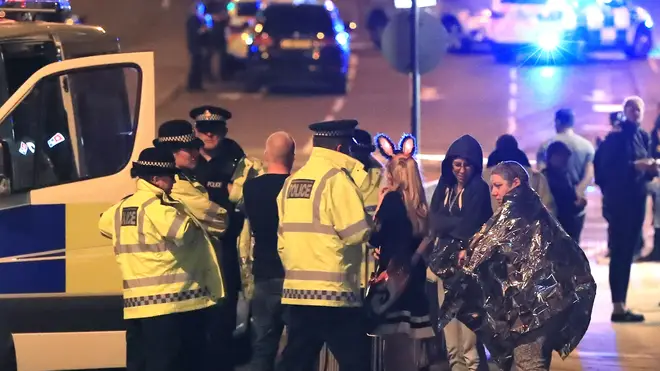
Iain Dale 10am - 1pm
8 September 2020, 19:09 | Updated: 8 September 2020, 19:10

A desperate 999 call from a member of the public treating a dying victim of the Manchester Arena bombing was played on the second day of the public inquiry into the attack.
Ronald Blake was trying to help stricken John Atkinson, 28, who had been caught in the blast carried out by suicide bomber Salman Abedi in the City Rooms, the foyer of the arena.
22 people were murdered and hundreds more injured in the attack on May 22, 2017.
Mr Blake rang within seconds of the blast as he tried to comfort Mr Atkinson and alert the emergency services.
"There's been an explosion at Manchester Arena, in the foyer," Mr Blake told the 999 call handler.
"There's loads injured. It's manic. Big explosion. I'm with a man now that's injured."
Mr Blake is then heard telling Mr Atkinson: "Alright mate. Don't try moving."
He returns to the call handler: "There's about 30, 40 injured. I'm with a man that's seriously injured. His legs really pumping."
Mr Blake, who was at the arena to pick up his daughter after the Ariana Grande show that night, was advised on the call to apply a tourniquet and keep on the line. The rest of the eight-minute call was not played.

Manchester Arena Merchandise Seller “Used T-Shirts” To Bandage Injured
Some relatives of those who died wiped away tears or held hands to their faces as the call was played at the inquiry hearing room in central Manchester. Mr Atkinson's family excused themselves from hearing the call.
Paul Greaney QC, counsel to the inquiry, said Mr Blake's conduct "showed the best of our community".
But the call also raised questions about the response of the emergency services, the hearing was told, in particular the response of North West Ambulance Service (NWAS).
Mr Greaney said the call, "literally seconds" after the explosion, alerted the emergency services to mass casualties and whether NWAS responded speedily and appropriately will have to be considered by the inquiry.
The first paramedic only arrived on scene 19 minutes after the blast. The hearing was told only two more paramedics were ever deployed, 20 minutes later, to treat the injured in the City Rooms.
Mass casualty vehicles were not deployed by NWAS and neither were stretchers to treat help the 22 who died and the hundreds left injured.
Experts concluded the NWAS response to the attack was "less than adequate in specific aspects".
Abedi, 22, detonated his shrapnel-packed home-made bomb at 10.31pm on May 22 2017 as hundreds of youngsters left the pop concert, many to meet parents waiting in the foyer to collect them. His brother Hashem was jailed for life last month with a minimum 55 years before parole for his part in the plot.

Manchester Arena victim: Hashem Abedi 55 year sentence isn’t enough
The inquiry also heard Mr Atkinson was only evacuated from the scene more than 40 minutes after the explosion and chest compressions only started on him more than an hour later.
The treatment of John Atkinson, 28, was highlighted as the response of the emergency services came under the spotlight on the second day of the inquiry in Manchester.
Mr Atkinson was only evacuated from the scene of the blast 46 minutes after suicide bomber Salman Abedi detonated his home-made bomb packed with shrapnel in the City Room, the foyer of the arena, at the end of an Ariana Grande concert.
Mr Atkinson was taken on a makeshift stretcher to a triage area of Victoria Station, which forms part of the arena venue site, and remained there for another 24 minutes but chest compressions were only started on him one hour and 15 minutes after he was first injured in the blast.
Paul Greaney QC, counsel to the inquiry, said: "The issue of John Atkinson's survivability is, as we shall explore, a significant issue for the inquiry to consider."

Manchester Arena attack survivor says anniversary will be different with lockdown
The inquiry also heard:
- The first paramedic arrived on scene in the City Room 19 minutes after the blast and was the only one there for the first 40 minutes.
- Only one stretcher was used during the incident, the hundreds of others injured being ferried using crash barriers, makeshift carriers or carried in arms.
- The fire service, which did have stretchers, only arrived on scene two hours and six minutes after the bomb went off.
- A terror training exercise, matching the real thing, had taken place in the City Room less than a year before the bombing.
Mr Greaney said it was important to acknowledge the huge pressure and the "agony of the moment" emergency service personnel were working under at the time.
"Within the first 10 minutes, at least 12 BTP officers had reached or were in the immediate vicinity of the City Room," he said.
"Those who entered offered assistance to the people they encountered.
"The inquiry may in due course conclude that in behaving as they did, they showed the very best of humanity, acting selflessly and without apparent regard for the dangers they themselves might be in in order to seek to help those who needed it."
But he added: "What we must do is probe deeply, if there were mistakes or failings, they will need to be revealed so the bereaved families know the truth and real lessons are learned."
Sir John Saunders is chairing the public inquiry, expected to run into spring 2021, which will look at events before, during and after the bombing, including the role of the emergency services.
The inquiry was adjourned until Wednesday morning.